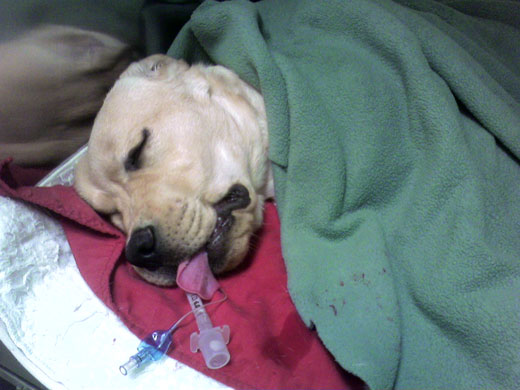 Members of our medical team once attended a lecture where the board certified anesthesiologist speaker defined veterinary anesthesia as “the controlled release of potentially lethal compounds.” We quickly embraced this definition and use it frequently with so we are always acutely aware of the importance of optimal anesthesia vigilance and subsequent positive outcomes. Does this mean we should fear anesthesia in dogs? Absolutely not. However, we need to respect it and minimize any risks that anesthesia inevitably presents when dogs need procedures that require it.
Members of our medical team once attended a lecture where the board certified anesthesiologist speaker defined veterinary anesthesia as “the controlled release of potentially lethal compounds.” We quickly embraced this definition and use it frequently with so we are always acutely aware of the importance of optimal anesthesia vigilance and subsequent positive outcomes. Does this mean we should fear anesthesia in dogs? Absolutely not. However, we need to respect it and minimize any risks that anesthesia inevitably presents when dogs need procedures that require it.
This information is especially important in this relatively new era of discount spay and neuter clinics that often cut costs by skipping some of the most important base principles of the safe administration of anesthesia in dogs. Thus, before scheduling anesthetic procedures for your dogs, always verify that these guidelines are being followed:
Thorough Pre-anesthetic Examination
At Grant Animal Clinic, even if a patient was diagnosed with a condition that requires an anesthetic procedure the day before, on the morning of the procedure, a full physical examination by the attending veterinarian and assessment of vital signs is performed prior to rounds. Many aspects of a patient’s health can change in a matter of hours let alone days. Thus, an updated examination on the morning of the procedure is an essential component to safe anesthesia administration in dogs.
For consistency and case and patient familiarity, Grant Animal Clinic assigns the same technician that will stay with the canine patient from check in, pre-anesthetic exam, blood testing, induction, intra-operative care, recovery and post-operative care, through to discharge.
Important Recommended Pre-anesthetic Tests
CBC – CBC stands for complete blood count and tells us about the red blood cell and white blood cell counts. Blood cell counts are important indicators of a patient’s systemic health and enable the veterinarian to make adjustments to anesthesia protocols to account for abnormalities.
Biochemistry Profile – This tells us about liver, kidney, and pancreatic function, as well as electrolyte and plasma protein levels. These parameters inform the veterinarian how efficiently and effectively the canine patient can process and eliminate anesthesia drugs. They also are important to aid the veterinarian in choosing the correct intra-operative fluid types and fluid administration rates.
Pre-medications
Grant Animal Clinic generally administers an opiate injection to the canine patient at least 20 prior to anesthesia. This serves first and foremost to reduce stress, which is a known factor that can increase the risk of anesthesia. For surgical procedures that will induce pain, an opiate injection also dramatically reduces postoperative pain by blocking pain channels before the pain stimulus occurs.
Intravenous Catheter
The intravenous catheter provides an open port through which anesthesia induction agents (induction drugs provide the deep sedation necessary to place an endotracheal tube for safe administration of the gas anesthesia), as well as life sustaining and lifesaving fluids and medications are administered.
Endotracheal Tube
Endotracheal tubes are placed in the trachea (the main airway in the back of the throat primarily responsible for breathing) that serves several purposes:
- Protect the airway from aspiration of saliva or vomit (canine patients occasionally vomit while under anesthesia).
- Provide precise oxygen and gas flow rates.
- Provide an easy means to ventilate the patient in the event of respiratory arrest.
Dedicated Veterinary Technician to Monitor Anesthesia
A dedicated veterinary technician to constantly monitor vital signs and parameters and monitoring equipment values is of the utmost importance. The technician is trained to recognize aberrations in values and vital signs in real time to assist the veterinarian with immediate intervention to maintain stability.
Monitoring Equipment and Parameters
The following are essential components to safe anesthesia monitoring:
- * Blood pressure – This is starred because aberrations in blood pressure cause our most common and serious anesthesia complications.
- ECG (electrocardiography) – Visible pulse wave of the heart.
- Pulse oximeter – Measures oxygen levels in the blood stream.
- Esophageal stethoscope – A probe that goes into the esophagus and provides an audible heart beat that is heard throughout the operating room.
- Capnometer – Measure carbon dioxide levels in the blood stream.
Grant Animal Clinic has one surgical monitoring device called the Surgivet that has all of these components in one piece of equipment.
What to Expect
Under the best and safest of circumstances, dogs after they have had anesthesia may experience some side effects for 24-48 hours that include:
- Drowsiness
- Panting
- Vocalization
- Restlessness
- Insomnia
- Inappetence
- Vomiting
- Loose stools
In most cases these issues are self-limiting. However, if in doubt, call Grant Animal Clinic or bring your dog in to be evaluated.
